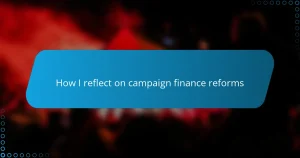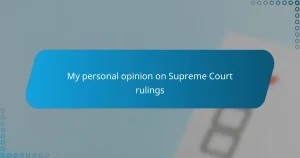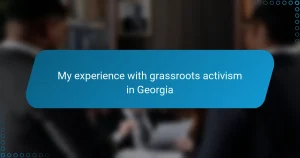Key takeaways
- Presidential speeches require analyzing tone, pauses, and emotional connections beyond the scripted words to understand their true intent.
- Key elements of effective speeches include clarity, emotional resonance, and consistency between promises and actions (speech integrity).
- Rhetorical strategies like repetition, metaphors, and contrasting ideas enhance the speech’s impact by shaping audience emotions and perspectives.
- Common pitfalls in presidential speeches include vagueness, overused clichés, and lack of emotional authenticity, which can disconnect the audience.
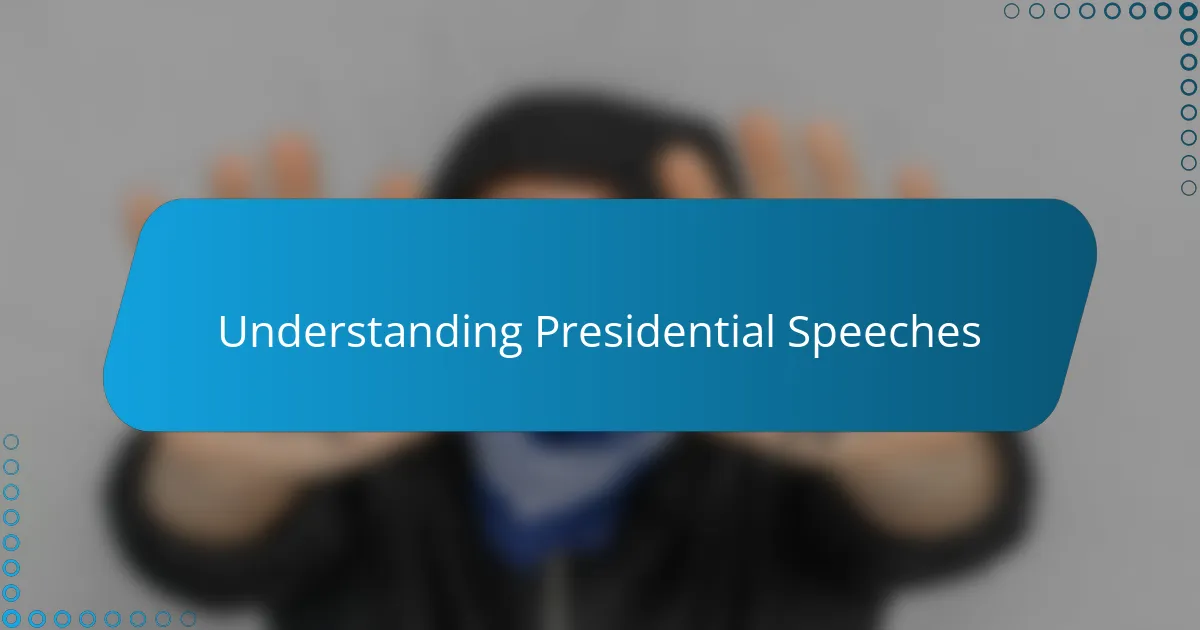
Understanding Presidential Speeches
Presidential speeches often feel like a complex code waiting to be cracked. From my experience, understanding them requires more than listening to words; it means tuning into the tone, the pauses, and the underlying message. Have you ever noticed how a simple change in emphasis can shift the entire meaning of a sentence? I have, and it always reminds me that speech is as much about delivery as it is about content.
I remember watching a State of the Union address where the president’s choice of personal stories made the political points hit much closer to home. Those moments aren’t just flair—they’re strategic tools used to connect emotionally with the audience. It makes me wonder, how often do we miss these subtle cues and just hear the surface message?
When I analyze these speeches, I ask myself: What is the president really trying to say beyond the scripted lines? The art lies in the unspoken intent and the context surrounding the words. Understanding this deeper layer transforms the speech from mere rhetoric to a window into the leader’s priorities and challenges.
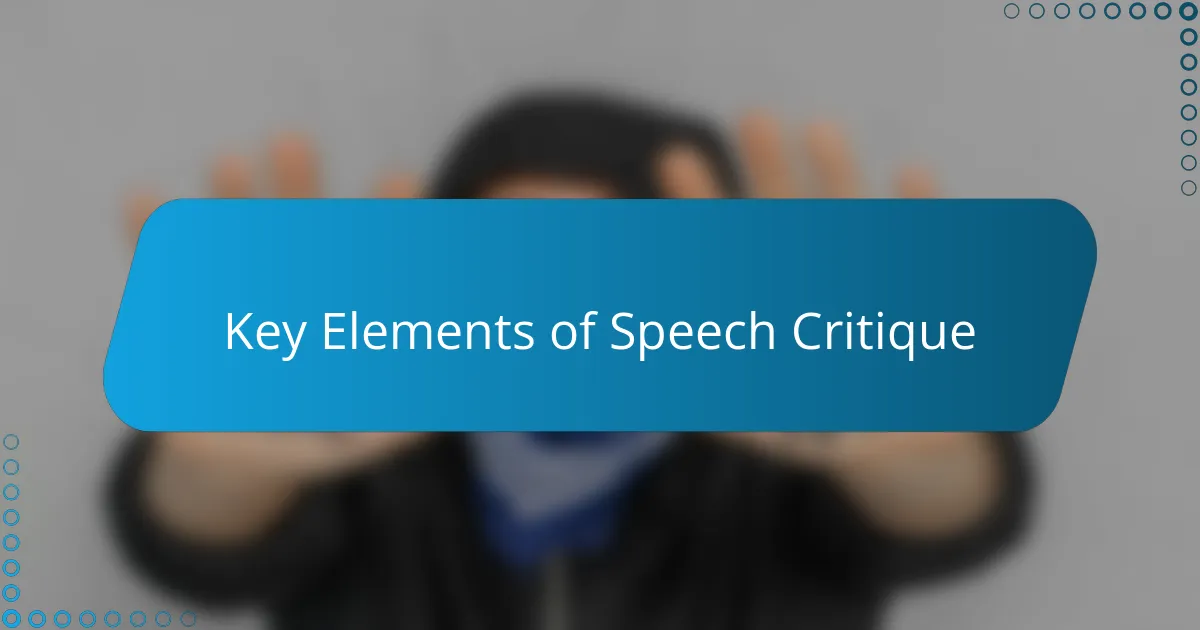
Key Elements of Speech Critique
To me, one of the first things I look for in a presidential speech is clarity. Does the president express ideas in a way that’s easy to follow, or do they get lost in jargon and vague phrases? I recall a time when a speech felt like a puzzle, and it frustrated me because powerful messages should be accessible, not confusing.
Another key element is emotional connection. I often notice how well the speech resonates with the audience’s hopes or fears. Have you ever felt a chill during a particular phrase or been moved to reflect deeply? Those reactions often come from a carefully crafted narrative that the speaker builds throughout the address.
Finally, I pay close attention to the consistency between words and actions—or what I call “speech integrity.” It’s one thing to promise change, but does the tone, examples, and emphasis truly support that promise? When I spot discrepancies, it makes me question the authenticity behind the speech, which is crucial in assessing its real impact.
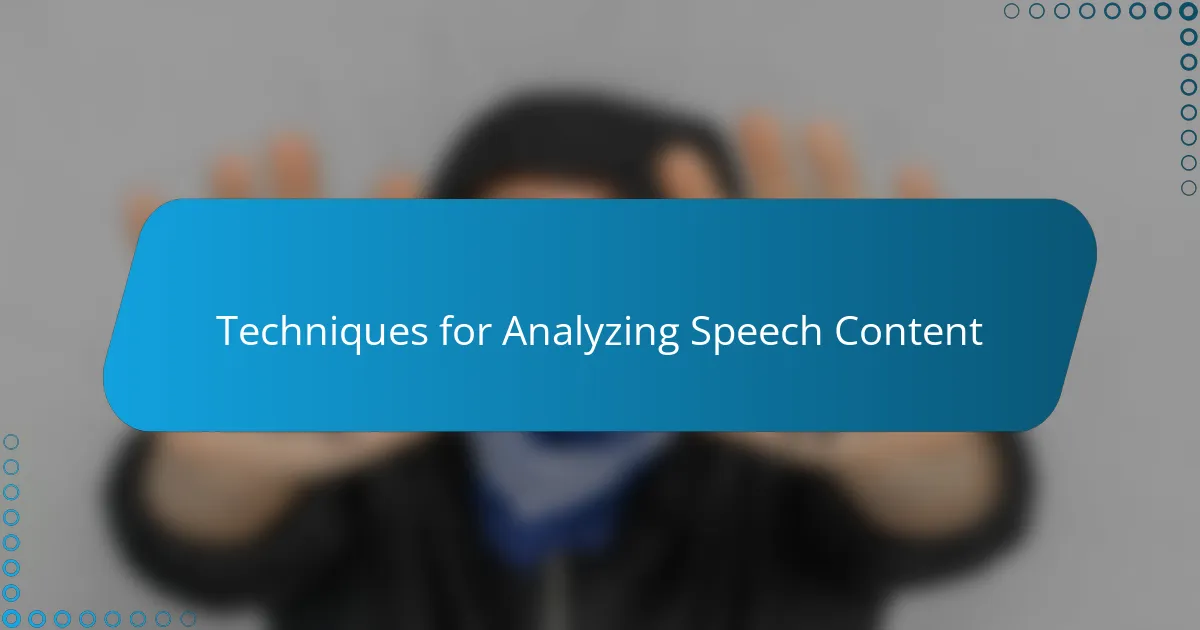
Techniques for Analyzing Speech Content
When I dive into analyzing the content of a presidential speech, one technique I rely on is identifying key themes that run throughout the address. It’s fascinating how certain words or ideas keep popping up, almost like threads weaving a larger narrative together. Have you ever caught yourself noticing a repeated phrase and wondered why the speaker keeps circling back to it? That repetition isn’t accidental—it’s a signal of what the president really wants you to focus on.
Another approach I use involves dissecting the choice of language—are the words strong and decisive, or vague and evasive? I remember listening to a speech where the president skillfully used inclusive language to create a sense of unity, which made me feel like I was part of a shared mission. This choice of words can either build bridges or walls, and catching those subtleties often reveals the speaker’s true intentions.
I also look closely at the balance between facts and emotional appeals. A well-crafted speech doesn’t just bombard you with statistics; it pairs them with stories or images that make those numbers come alive. Have you noticed how a single anecdote can make a complex policy feel urgent and personal? That’s where the power of storytelling blends with data to persuade or inspire, and I find analyzing this mix invaluable for truly understanding the speech’s impact.
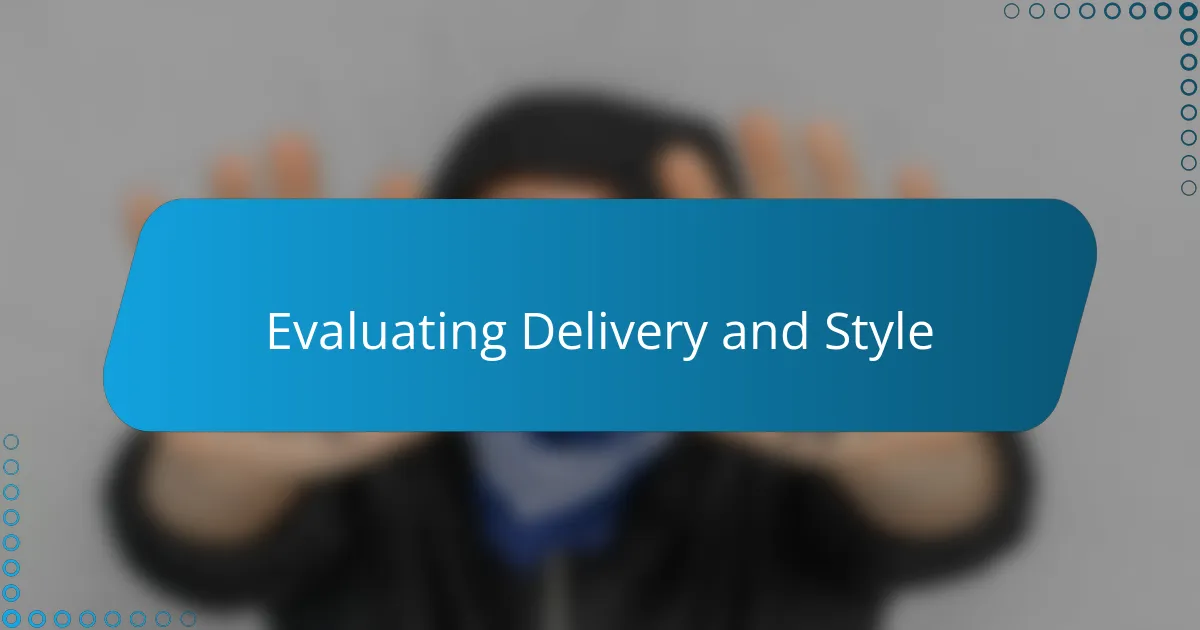
Evaluating Delivery and Style
Delivery and style can make or break a presidential speech, in my experience. Sometimes, a strong, steady voice commands attention, while other times, subtle changes in pace or tone reveal genuine emotion or urgency. Have you ever felt instantly drawn in by the energy behind a leader’s words? That’s the magic of effective delivery.
I recall a particular speech where the president’s measured pauses gave weight to each idea, letting them resonate longer in my mind. It was as if the silence spoke just as loudly as the words themselves. This taught me to listen not only to what is said but how it’s said—the rhythm and cadence can be just as persuasive.
On style, I’m always curious about how a president balances formality with relatability. Too stiff, and it feels distant; too casual, and it risks losing authority. Finding that sweet spot is an art, and when done well, it makes the speech feel authentic and accessible. Does the style fit the moment, or does it create dissonance? That’s a key question I keep asking.
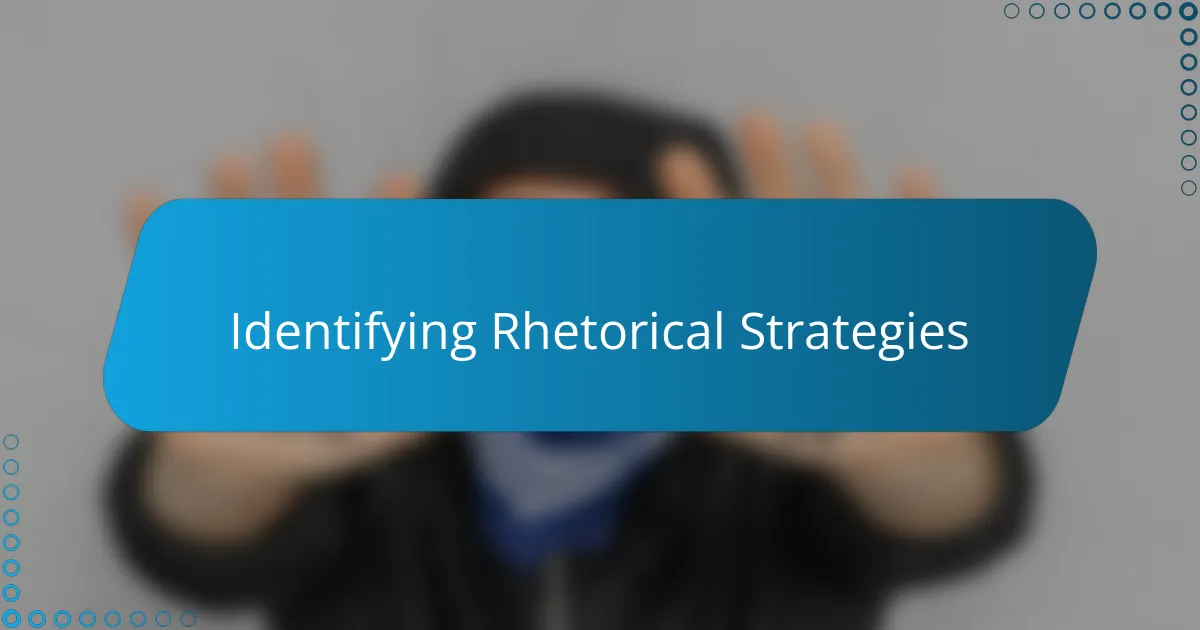
Identifying Rhetorical Strategies
Identifying rhetorical strategies is like uncovering the blueprint behind the speech’s emotional and intellectual impact. I often find myself zeroing in on devices like repetition and parallelism—those deliberate patterns that lodge key ideas in your mind without you even realizing it. Have you ever caught a phrase echoing throughout a speech and wondered why it sticks with you? That’s no accident; it’s a classic rhetorical move to reinforce core messages.
Metaphors and vivid imagery also draw my attention because they turn abstract policies into concrete emotions we can all relate to. I remember a speech where the president described the nation as a “bridge under construction,” and suddenly the concept of progress felt tangible and urgent. These strategies don’t just decorate the speech—they shape how we visualize and emotionally respond to complex issues.
And then there’s the power of contrast—setting up binaries like “us versus them” or “past versus future” to frame the argument in a way that feels immediate and compelling. When I spot these juxtapositions, I ask myself how they influence the audience’s mindset. Are they fostering unity or division? That question often reveals the underlying intent behind the rhetoric, giving me a clearer lens through which to critique the speech.
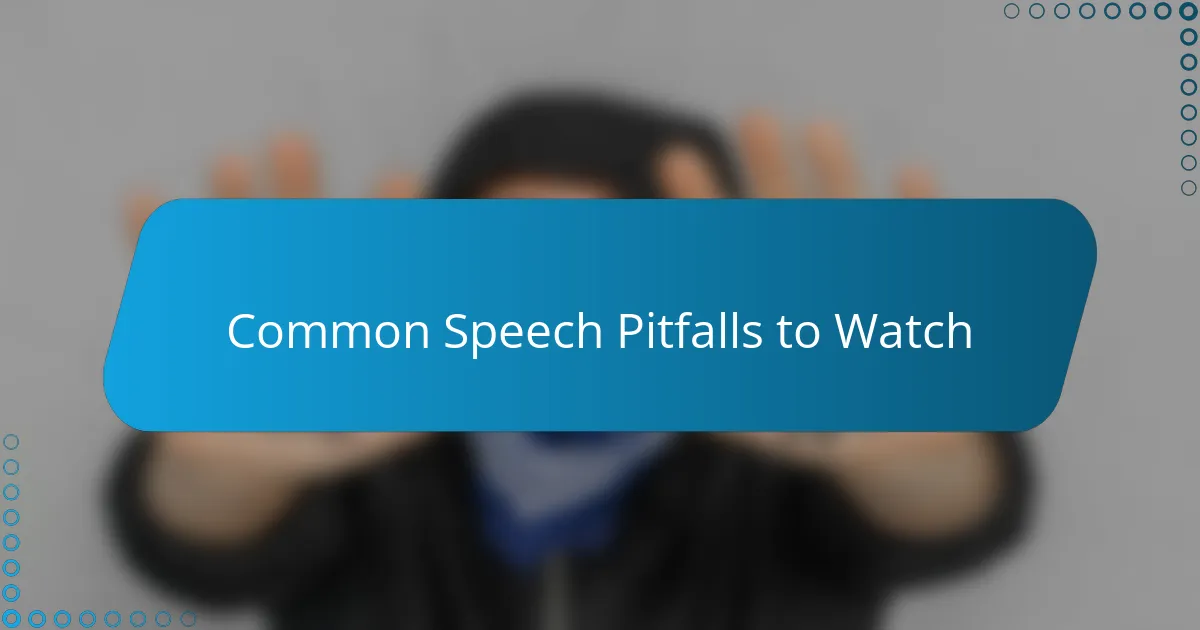
Common Speech Pitfalls to Watch
One pitfall I often see in presidential speeches is the overuse of vague generalities. Sometimes, it feels like the speaker is skirting around real issues, using broad statements that don’t say much. Have you ever found yourself waiting for a clear point that never quite comes? I’ve noticed this leaves me frustrated, because it makes the speech feel hollow or evasive.
Another common trap is relying too heavily on clichés. I once listened to a speech peppered with phrases so familiar they lost all impact. When every sentence feels recycled, it’s hard for the message to resonate or inspire. From my experience, originality matters—a fresh turn of phrase can make all the difference in holding people’s attention.
Finally, lack of emotional authenticity stands out as a crucial pitfall. Sometimes a speech sounds rehearsed or robotic, missing that human connection. I recall feeling disconnected from a particularly polished address that lacked genuine warmth or passion. It made me realize how important it is for leaders to let their true emotions show, or risk alienating the audience entirely.
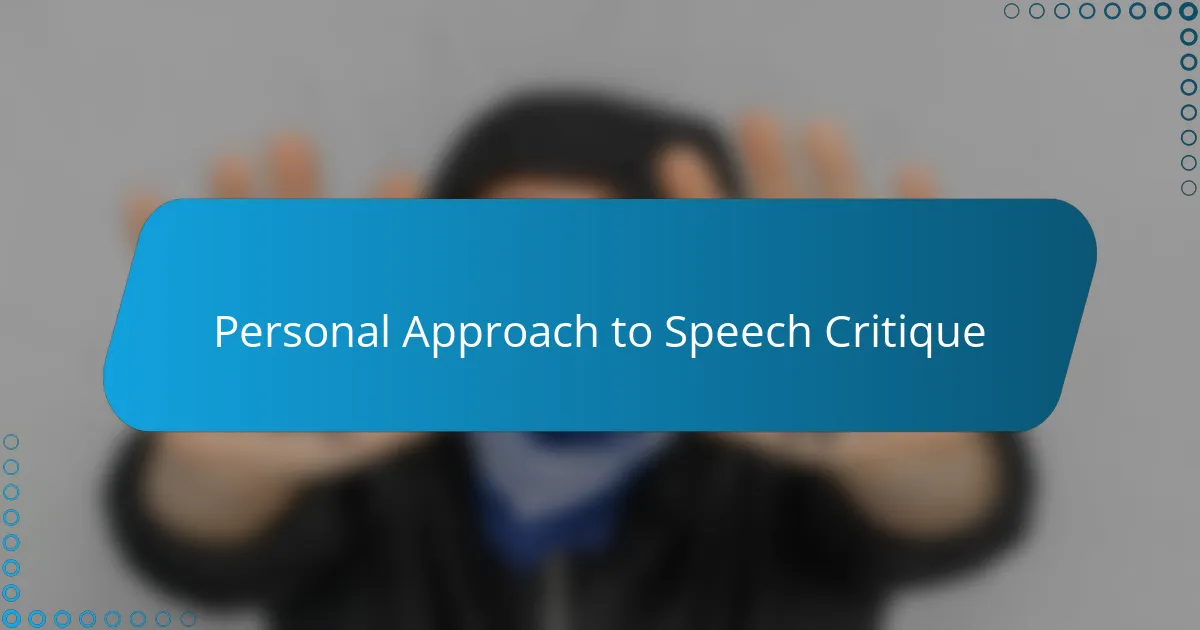
Personal Approach to Speech Critique
When I critique presidential speeches, I don’t just glance at the words—I immerse myself in the overall experience. I ask, “How did this make me feel, and why?” Often, it’s the emotional undercurrents that reveal as much as the facts laid out. I remember analyzing a speech where the tone shifted subtly between hope and caution, and that personal “feeling” guided me to understand the president’s real stance beyond the text.
Another part of my approach involves being mindful of context. I think about what’s happening in the country when the speech was delivered and how that shapes the message. It’s almost like piecing together a puzzle, where the speech alone isn’t enough—you need to see the bigger picture to evaluate impact and intent. Has this helped me avoid jumping to conclusions? Absolutely.
Lastly, I believe in balancing precision with empathy. Sure, pinpointing weak arguments or inconsistencies is important, but I also look for moments where the speaker connects authentically with people’s struggles or aspirations. Isn’t it fascinating how a genuine pause or a personal anecdote can turn a routine speech into something memorable? That human touch is often my benchmark for judging a speech’s true effectiveness.
